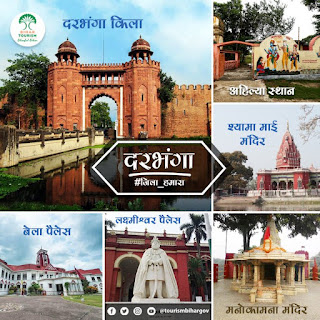Exploring the Cultural Heritage of Darbhanga - India's state of Bihar has the city of Darbhanga, which is rich in cultural history. The monuments, antiques, and customs of the city, which have been kept and passed down from generation to generation, are a testament to its rich past. Traveling through Darbhanga's cultural history is like travelling through time, learning about the city's intriguing past and how it has shaped the present. Let's examine some of Darbhanga's most significant structures and artefacts in more detail to better understand its rich cultural legacy.
Tourist Attractions Exploring the Cultural Heritage In and Around Darbhanga -- Raj Quilla
- Ahilya Sthan
- LNMU Campus
- Kankali Temple
- Shyama Temple
- Manokamna Mandir
- Chandradhari Museum
- Mahinam-Mahadeo-Sthan
- Kusheshwarasthan Bird Sanctuary
- Maharaja Laxmiswar Singh Museum
A Journey Through Darbhanga's Monuments and Artifacts -
The Raj Bhavan Palace, commonly referred to as the Rajendra Mandir, is one of Darbhanga's most well-known landmarks. Maharaja Lakshmeshwar Singh of Darbhanga, who was well-known for his love of architecture and the arts, erected this beautiful palace in the 1920s. The palace includes lovely gardens, courtyards, and fountains and is a stunning fusion of Rajput and Mughal architectural styles.
The Kankali Temple, which is a prominent landmark in Darbhanga and is situated in the centre of the city, is yet another example of the city's rich cultural legacy. The temple, which honours the goddess Kali, is thought to have been constructed more than 200 years ago by the Darbhanga royal line. The temple's exquisite sculptures and distinctive colour scheme are a combination of Islamic and Hindu architectural elements.
Another must-see location for those interested in learning about Darbhanga's cultural past is the Maharaja Laxmiswar Singh Museum. A large collection of items, including paintings, sculptures, coins, and manuscripts, are on display at the museum, which is located in a 150-year-old palace. Via the museum's collection of furniture, textiles, and other domestic artefacts, visitors may also gain a look into the royal family of Darbhanga's way of life.
The cultural legacy of Darbhanga extends beyond its monuments and relics. The city is particularly well-known for its traditional crafts, such as the elaborate designs and vivid colours of Madhubani paintings, which have won attention all over the world. The paintings, which use natural dyes and pigments, show scenes from Hindu mythology and daily life.
Darbhanga is renowned for its handloom textiles, such as the Bhagalpuri silk sarees and the Tussar silk fabrics, in addition to its Madhubani paintings. These textiles, which are woven utilising conventional methods, are renowned for their stunning patterns and sturdiness.
Discovering Darbhanga's cultural legacy is an adventure since it provides a window into the city's illustrious past and how it has shaped the present. Darbhanga's cultural history, which ranges from its beautiful palaces and temples to its traditional crafts and textiles, is proof of the city's tenacity and fortitude. Darbhanga's cultural legacy is certain to enthrall and inspire you, whether you are a history enthusiast, an admirer of art, or simply someone who appreciates learning about different civilizations.










